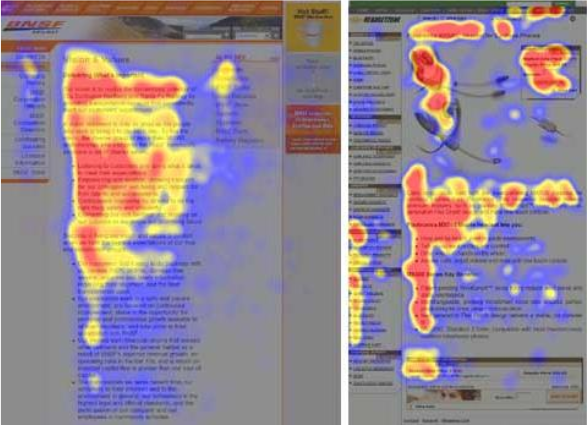Sadly it’s true though. On average a user will only read 20% of the content on your page.
There is one very simple reason for this slightly depressing fact… scanning.
You could stop reading this article now because I’ve already spoiled the ending (more on that later). But if you want to know why people scan and how do deal with it then please read on.
If you want to learn lots more about writing for the web from somebody who’s been in the business for years, try our online copywriting or online copywriting advanced training courses.
Scanning
People don’t read a web page in the same way as they do a book or a newspaper. When people browse the web they are looking for quick answers.
This isn’t just the educated guesswork of an online writer. Eye-tracking studies have found that the majority of people read online content in an ‘F’ pattern.
The image below shows you what the F pattern looks like. It is a heat map, so the red parts are where people spent the most time looking and the blue parts the least time.

The F shape explained
As you can see from the image above, the heat map generated by the eye-tracking study forms a rough F shape. Let’s break down each part of the shape.
- Horizontal movement across the first paragraph forms the top of the F.
- Second horizontal movement slightly further down that covers a shorter area than the first.
- Vertical scanning of the left side of the content.
Why do people scan?
Are we getting lazier? Less literate? The continuing popularity of door-stopping novel series such as George RR Martin’s A Song of Ice and Fire would suggest not.
You could argue that it is simply more difficult to read lots of text on a computer screen. It strains the eyes and therefore makes it far less pleasant than reading something on paper.
But there is another simple reason for people scanning in this way: they are looking for a specific piece of information and they don’t want to read the whole article to find it.
Think about the behaviour of someone using a search engine. They are ultimately looking for an answer to a question.
They will click on a link and scan the content for that answer. If they don’t find it quickly and easily they’ll leave, go back to the search engine and try another link.
How to write for scanners
Here are some other things you can do to make scanners’ lives easier, which should always be your aim when writing online content:
- Create bulleted lists like this.
- Use plenty of descriptive subheadings.
- Write in short paragraphs.
- Give each point or idea its own paragraph.
- Create plenty of white space.
- Highlight key points in bold.
- Put important information near the beginning of sentences and paragraphs.
You can see from this post that I use paragraphs of only one or two sentences. This helps create the white space I mentioned so people can easily scan the article for what they want.
I also use simple language so that someone scanning the copy can easily pinpoint what they’re looking for without having to struggle with technical jargon or marketing fluff.
Keep everything clear and easy to navigate. Remember you are dealing with fickle readers who will make a decision about the usefulness of your content within seconds.
I’m not saying you should dumb things down for your readers, but yes actually that’s exactly what I’m saying. Far from patronising them you’ll actually make their lives easier and they’ll thank you for that.
If you got into online writing because you wanted to be the next literary great then you’re in the wrong business. This is the business of delivering information as quickly and clearly as possible.
Spoilers welcome
You should also aim to get the main point of the article into the first couple of paragraphs.
I mentioned earlier that I’d spoiled the ending of this post. The point of the article is that people only read 20% of content because they scan, and like I said you could have stopped there.
You’re not writing a thriller novel, so forget about building mystery and revealing the big twist at the end.
Tell people your main point/s as early as possible and as clearly as possible. Then go into further detail in the rest of the article for those that want to read it.
Did you scan this post?
I’d be interested to know how much of this post you actually read, or how much of an article you think you usually read in general. Please let me know in the comments.
I promise I won’t be offended if you only say 20%.
Most important, don’t bury the lede. Make sure that the most important information is at the top. A useful trick is to go back, after you’ve written an article, and consider deleting the first few introductory paragraphs.
https://www.merriam-webster.com/words-at-play/bury-the-lede-versus-lead